Starting a business doesn’t mean writing a 40-page plan no one reads. In fact, according to the Harvard Business Review, entrepreneurs who write simple, focused plans are 16% more likely to build successful businesses.
If you're a solopreneur juggling a million tabs (and probably a side hustle), one page business plans are your sanity-saver. It's fast, clear, and action-ready—and yes, you can write one before your next coffee break. Let’s dive in.
What Is a One Page Business Plan?

A one page business plan is a short version of traditional business plans. It fits your full business concept, target market, and business goals into a single page. Sounds simple, right? That’s the point.
It helps solopreneurs, business partners, or even an established business stay focused without getting lost in paperwork.
As Forbes puts it, “Short plans improve clarity and boost action.” So, if writing a detailed business plan feels like a daunting task, start here—on your business plans.
Why a One Page Business Plan Beats the Traditional Business Plan

Most people don’t finish their traditional business plan. It’s too long, too complex, and often outdated by the time it’s done. But a one page business plan is faster, easier, and more effective—especially for solopreneurs, startups, or an established business with limited time.
According to the U.S. Small Business Administration, businesses with a simple plan grow 30% faster. Here’s why this one page plan works better, including a thorough industry analysis:
- It Saves Time and Cuts the Fluff: You can finish it in just a few minutes. No unnecessary sections or jargon. Perfect for busy founders juggling multiple roles.
- It’s Easier to Update as You Grow: Plans change—fast. A concise document makes it easy to revise goals, financial projections, or your marketing plan. Better than rewriting a full length business plan every quarter.
- It Gets Straight to What Matters: Investors want clarity. You focus on value proposition, target market, and your business model—not 20 pages of filler. Helps you define your business mission and stand out.
- It’s Easier to Share With Business Partners: Share it with your business partners, potential investors, or your management team quickly. Everyone stays on the same page—literally.
Key Elements of a High-Impact One Page Plan
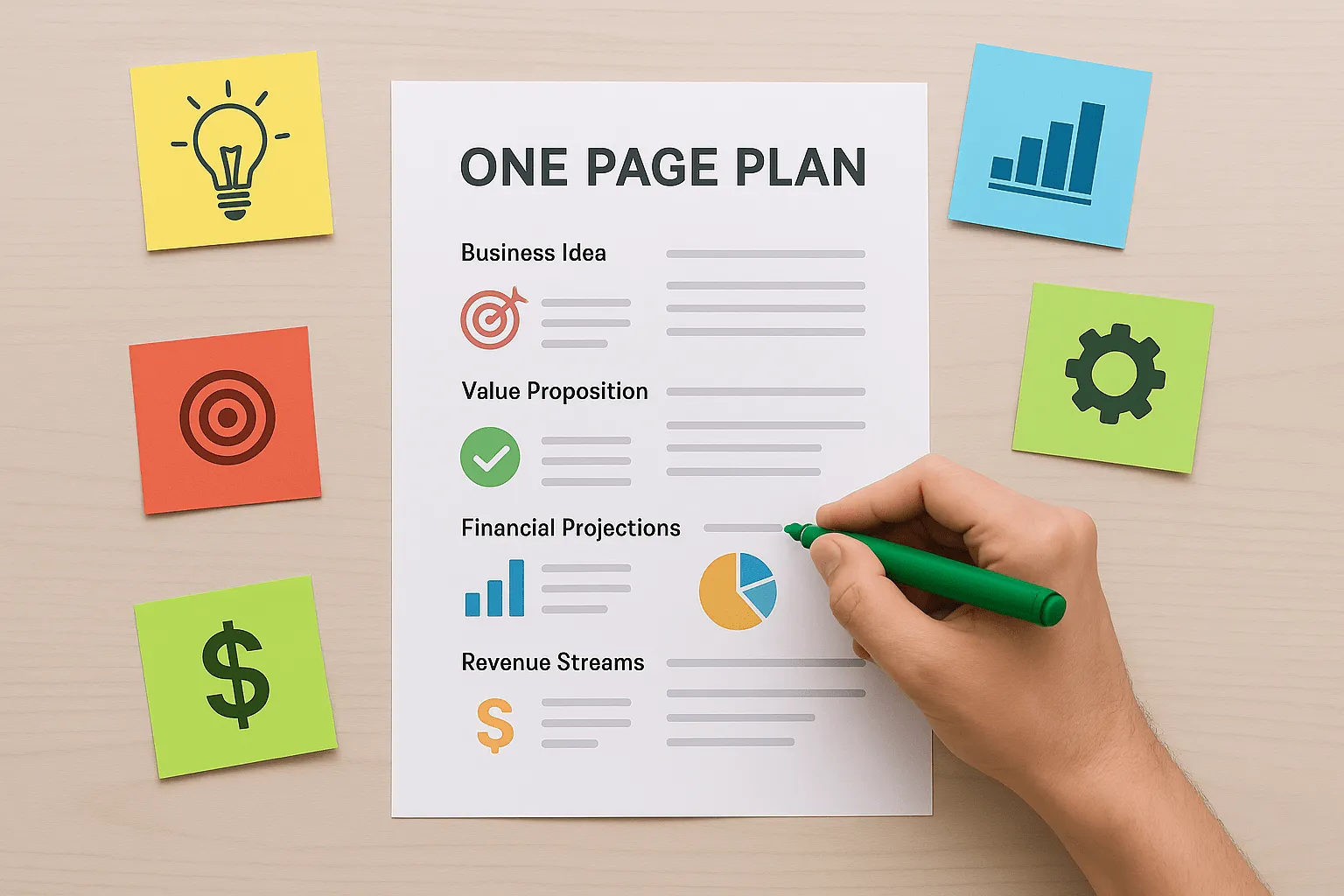
1. Problem Statement That Hits Home
Every business solves a problem. Start with this. What’s the pain point? Who’s feeling it? Use one or two lines to explain it.
Example: “Busy parents don’t have time to cook healthy meals. We make ready-to-eat options that save time and stress.”
This connects your business idea with your target market. It shows why your business exists.
2. Snapshots of Social Proof or Traction
Even small wins build trust. Add quick facts that show people like your product.
- Have 100 users? Say it.
- Got great feedback? Quote it.
- Made your first sale? Brag about it.
This makes prospective investors and business partners pay attention.
“In our first 30 days, we made $1,200 in sales from local Facebook ads.”
This enables business owners to show you're not just dreaming. You’re doing.
3. Visual Business Model Canvas (Simplified)
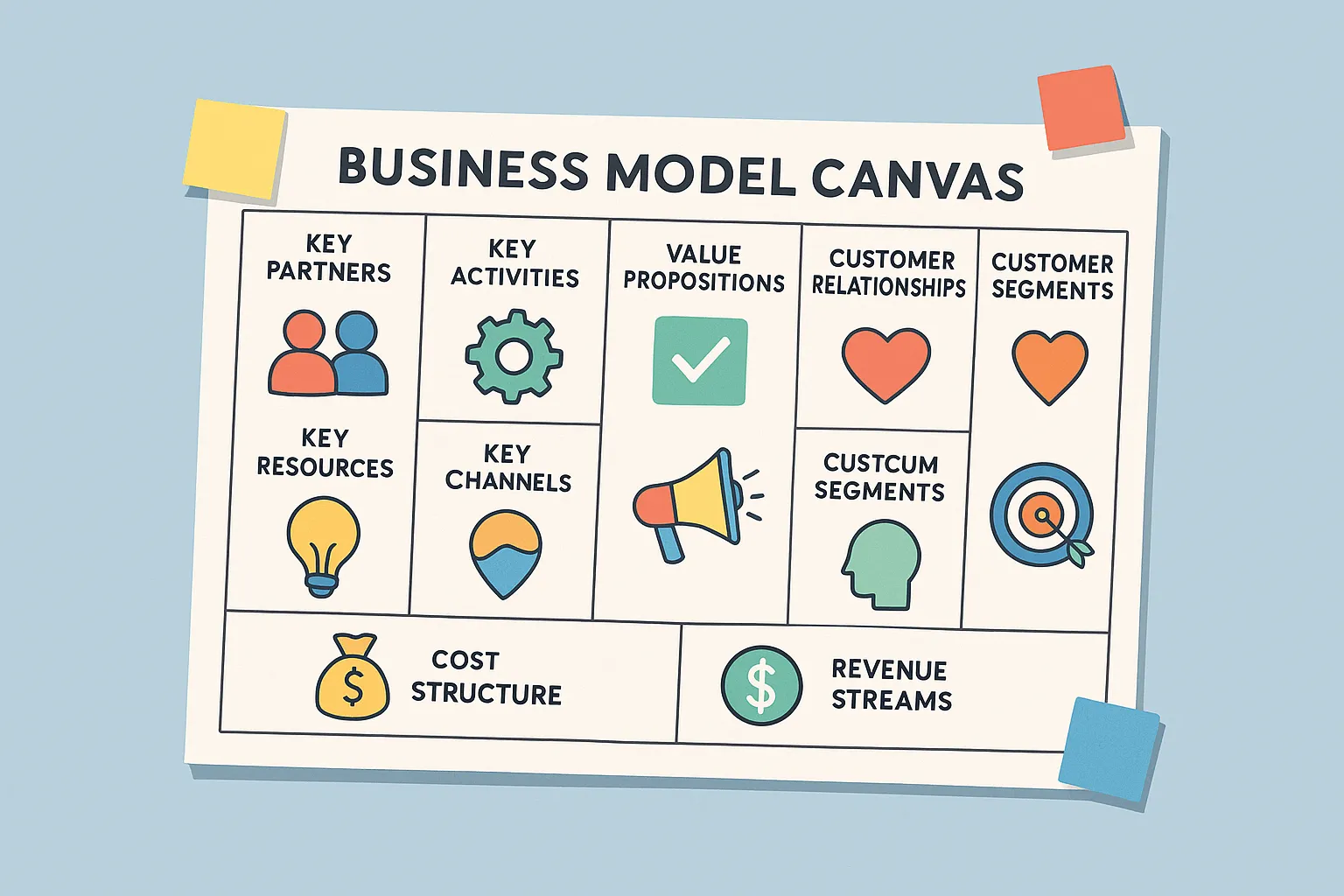
Use a simple chart or business plan template to show the core aspects of how your business works. Include:
- Your business model (how you make money)
- Customer segments (who you help)
- Revenue streams and cost structure (money in, money out)
- Your unique value proposition (what makes you different)
Even a basic version helps you and others “get it” fast. Tools like Canvanizer or Miro make it easy—even free.
"Great plans are clear, not complicated." — Lean Startup author Eric Ri
4. Clear “Why Now” Insight
Timing matters. Your one page business plan should explain why this business makes sense today—not someday.
- Is there a new problem people are facing?
- Is the market changing fast?
- Is there a trend or tech shift helping you?
Example: “With food costs rising, people want affordable meal kits more than ever.”
Investors and business partners care about timing. Showing a competitive advantage based on current demand helps you stand out.
5. The People Behind It (Even If It’s Just You)
People invest in people. Use this section of your one page plan to highlight your management team or yourself—if you’re solo.
- What experience do you have?
- What skills make you the right fit to solve this problem?
- Mention any advisors or co-founders if you have them.
Example: “Founder with 8 years in logistics and a background in e-commerce. Built and sold a Shopify store in 2022.”
This adds credibility to your business concept. It helps potential investors trust your ability to deliver. Even a simple executive summary line here boosts the strength of your one page business plan.
How to Write a One Page Business Plan in Just a Few Minutes
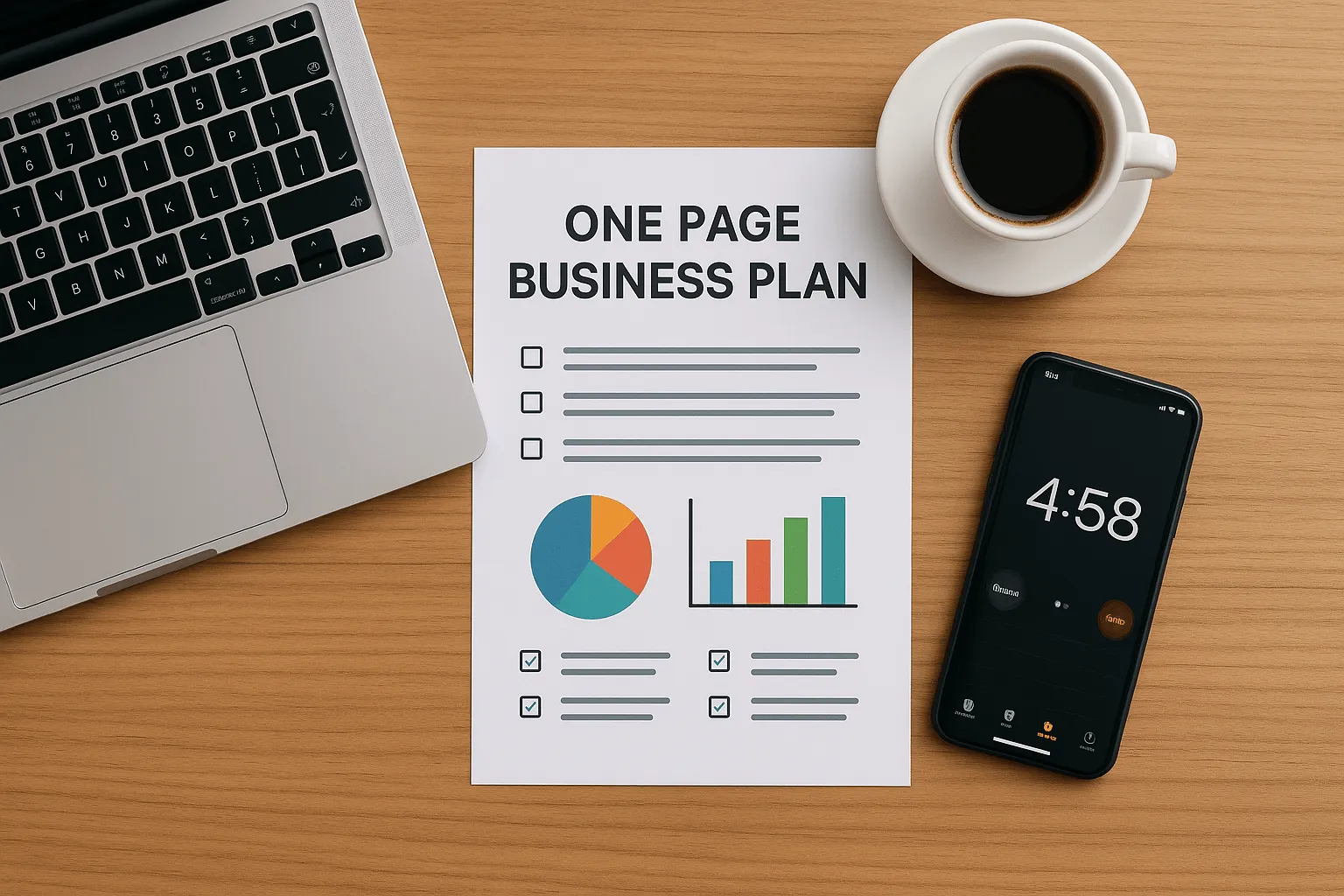
1. Start with Your Business Idea—Keep It Clear
What are you building, selling, or solving? Say it in one sentence, focusing on your key activities.
How to write it:
- Think like a customer. What problem are you solving?
- Keep it short. One line is enough.
- Use plain words. No buzzwords.
Example: “We deliver healthy meals to office workers who don’t have time to cook.”
That’s your business concept. Simple and strong.
2. Define Your Target Market
Who are your customers? Be specific. Don’t say “everyone.”
How to write it:
- Age group? Job type? Location?
- Are they families, students, small business owners?
- Where do they spend time—online or offline?
Example: “Busy moms aged 30–45 in Atlanta who shop online and follow parenting blogs.”
Knowing your target market helps with your marketing channels and plan later. It also shows you’ve done basic market research and developed a marketing strategy.
3. Craft Your Value Proposition

Why should anyone care about your business?
How to write it:
- What makes you different?
- What benefit do customers get?
- Why should they choose you over others?
Example: “We’re the only meal service offering organic, family-size dinners in under 20 minutes.”
This is your unique value proposition—and it’s key to getting noticed.
4. Outline Your Business Model
A business model is how your business makes money.
How to do it:
- List your main revenue streams.
- Share your cost structure—what you’ll spend on.
- Add your customer segments—who you serve.
- Include your unique value proposition.
Example: “We sell $30 monthly meal kits to 25–40-year-old remote workers. Our costs are $12 per kit.”
You can use a business model canvas if you want to visualize this. It’s simple and helpful, especially when it includes business plan templates and financial statements.
5. Add Your Marketing and Sales Strategy
This is how people will find you—and why they’ll buy.
How to do it:
- Define your marketing plan. Where will you promote—Instagram, email, or local ads?
- Include your sales strategy. Will you do demos, free trials, or one-on-one calls?
Example: “We’ll run Instagram ads and collect emails through a free PDF. Then we’ll call warm leads weekly.”
This helps show you’ve thought beyond the idea. It’s how you’ll reach your target audience.
6. Keep Financial Projections Simple
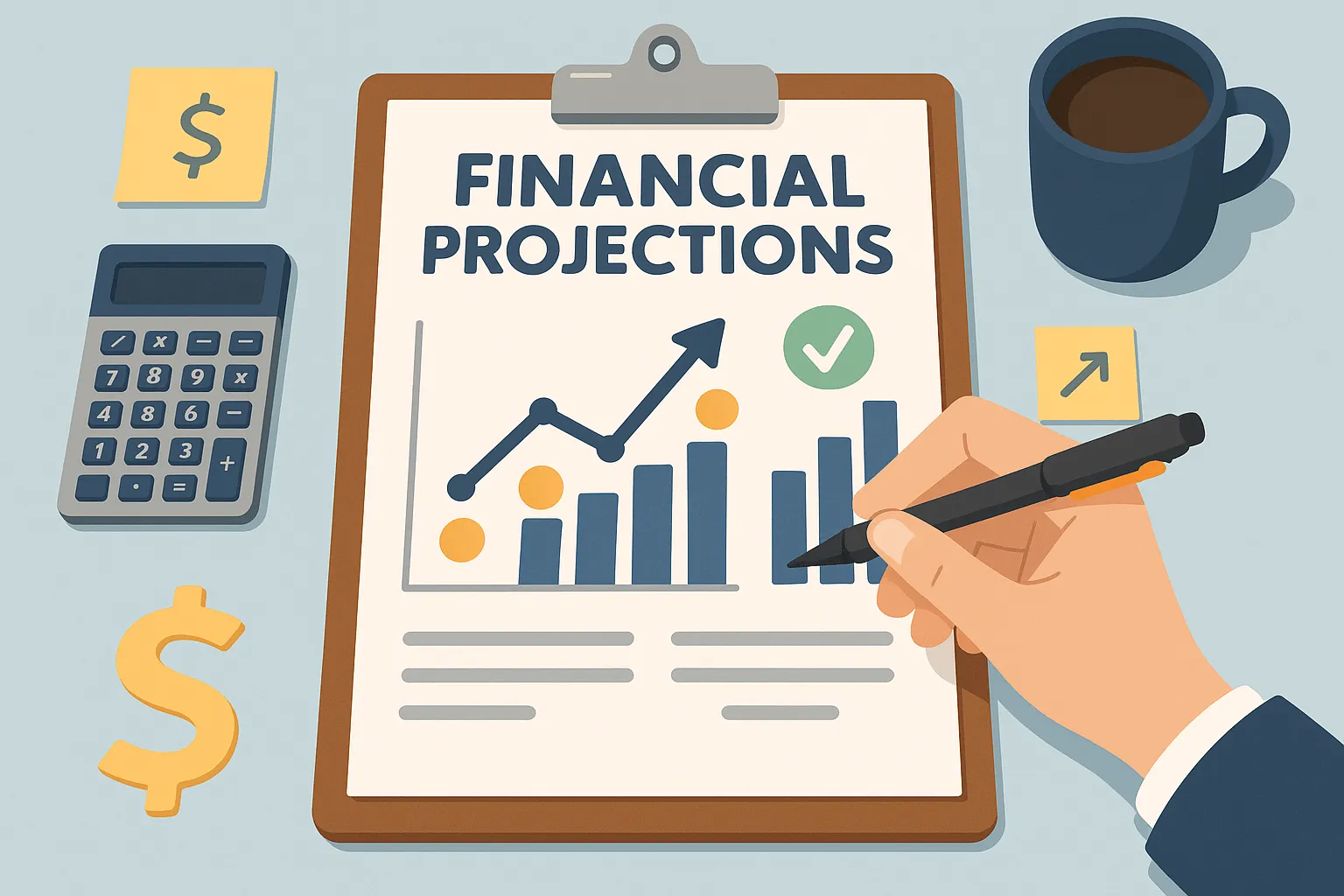
You don’t need a full spreadsheet. Just show your funding requirements, including where money is coming from—and where it’s going.
How to do it:
- Share your monthly revenue and expense estimates.
- Add a quick financial summary: expected profits, basic cash flow, or when you’ll break even.
Example: “We plan to earn $5,000/month by Month 4. Costs stay under $3,000/month.”
It doesn’t have to be perfect. But potential investors and even your business partners will want to see this.
7. Mention Key Milestones and Goals
Your one page business planning should show where you're going. That means writing down key milestones—big moments you want to hit—and your business goals.
Think about what success looks like in 3 months, 6 months, and 1 year. Maybe it's getting your first 50 customers. Or launching a product. Or making ₹5 lakh in revenue.
Here’s how to do it right:
- Write 3–5 clear goals. Keep them realistic.
- Set dates for each goal.
- Add 1–2 key milestones per goal.
- Track your progress monthly.
8. Use a One Page Template
Don't start from scratch. A one page template helps you stay focused and save time. It guides you through the essential elements without getting lost in too many details.
Here’s what a good template includes:
- Business idea in one sentence
- Target market and ideal customer
- Unique value proposition
- Simple business model
- Basic financial projections
- Clear marketing plan and sales strategy
- Key milestones and goals
- Your contact details
Do You Need Business Partners for Your One Page Business Plan?
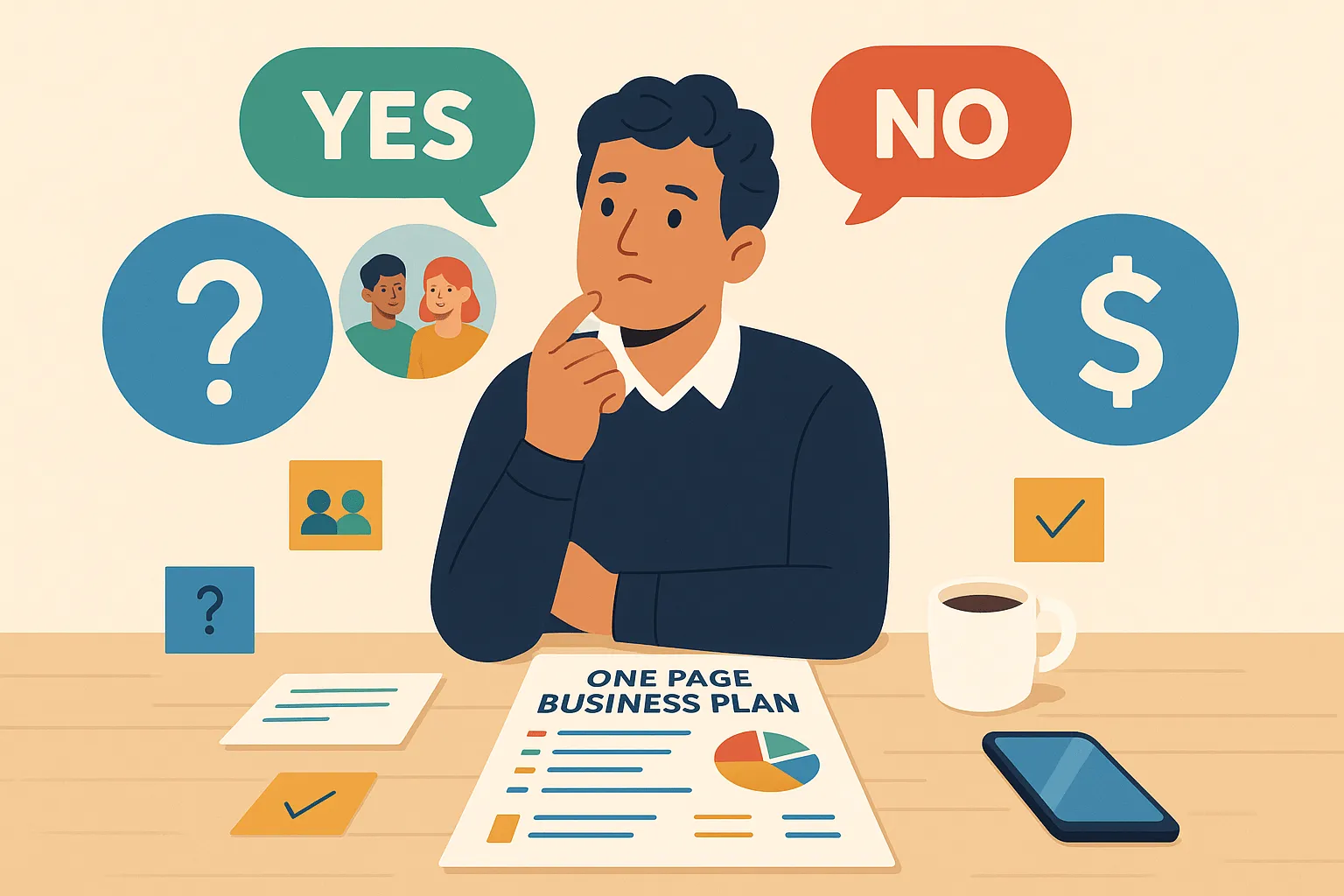
1. List Key Roles & Responsibilities
- If your business concept needs someone who can code, market, or manage finances—and you can’t do all three—you need a partner.
- On your one page business plan, write down who is doing what. This helps avoid confusion and future fights.
2. Align on the Business Mission
- Make sure all business partners agree on the business mission. Your mission is the reason your business exists.
- Add this to your one pager. Everyone should believe in the goal. No half-hearted team members.
3. Be Transparent About Equity and Expectations
- Talk about money and ownership from the start. List it clearly in your business information section.
- How much time is each partner putting in? What share will they get? Honest talks now will save trouble later.
4. Communicate Often, and Document Decisions
- Even with a concise document, write down key decisions. Check in weekly. Use your key milestones to guide progress.
- This keeps everyone on track—and focused on results.
5. Use the One Page Plan as a Partnership Test
- A good one page business plan shows if your partnership will work. If your partner avoids filling it out or disagrees on basics—red flag.
- Think of your one page plan as both a roadmap and a filter.
How to Effectively Convey Your Unique Value Proposition

Your one page business plan should clearly tell people why your business matters. That’s your unique value proposition—the one thing that makes you better, faster, or more helpful than others.
What Is a Unique Value Proposition?
It’s a short statement that shows the value you give your target market. It answers: “Why should someone choose your business idea over others?”
For example, instead of saying, “We sell shoes,” say: “We deliver stylish, pain-free shoes for nurses who stand all day.”
How to Make Yours Clear in a One Page Plan:
- Keep it simple. Use clear, everyday words.
- Be specific. Don’t say “best quality.” Say what makes it better.
- Think like your customer. What problem are you solving?
Include It in These Places:
- Your business model box (how you create and deliver value)
- In the executive summary
- As part of your marketing plan or sales strategy
Turn Your Plan into Action: What to Do After It's Written

1. Break Your Plan into Weekly Tasks
Take your goals and break them down. What can you do this week? What needs to be done next week?
This step makes your business goals feel less scary.
Use a calendar or free app to stay on track. Each task should connect to a part of your business model—like your sales strategy, marketing plan, or financial projections.
Pro tip: “Small actions build big results,” says Sarah Green, a small business coach from California.
2. Build a Simple Implementation Timeline
Set clear dates. This gives you structure. If your executive summary mentions a launch next quarter, then backtrack each step.
Use a color-coded chart or checklist. This turns your one page business plan into an implementation timeline you’ll actually follow.
Include milestones like:
- First sale
- Website launch
- Targeting your ideal customer
- Testing your pricing strategy
3. Share It With Someone Who’ll Hold You Accountable
Find a mentor, business partner, or trusted friend. Tell them your weekly goals. Ask them to check in.
Having someone hold you to your plan boosts success.
If you’re running a single page business plan for a new business, this kind of support makes a huge difference.
4. Test and Tweak One Section at a Time
Your one page business plan is not set in stone. It’s a living, breathing document, unlike a comprehensive business plan. Start small. Don’t change everything at once.
Focus on one section, like your target audience or marketing plan. Try a new sales channel, update a number in your financial summary, or rewrite your value proposition. See what works in real life.
For example, if your business concept includes a product launch, test it with just 10 people. Get feedback. Learn what to keep and what to fix.
5. Review Monthly—Not Yearly
Don’t wait a whole year to check your progress. Monthly reviews are quicker and more helpful—especially with a concise document like a one page business plan.
- Ask: What changed this month?
- Are you hitting your mini-goals?
- Does your financial plan still make sense?
- Is your target market still the same?
Use your review to celebrate wins and spot red flags. A one page plan makes it easy to adjust without redoing the whole thing.
Conclusion
A one page business plan helps you save time, stay focused, and communicate your business strategy clearly. It's not just for startups—it fits any business opportunity. Whether you’re building a comprehensive plan or a simplified version, this tool makes planning easy. Use a free template to start. Smart planning begins with just one page.








